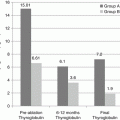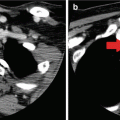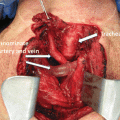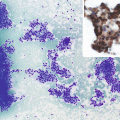Sensitivity
Specificity
Ultrasound [29]
63–87
80–94%
92%
90%
MRI [27]
90%
95%
88–92%
64–87%
In terms of correlation between physical exam findings and ultrasound findings, a number of studies have shown a weak correlation. In a sample of 2441 patients, physical exam was able to palpate nodules in 169 patients, while ultrasounds located nodules in 249 patients. Of the nodules located on ultrasonography, only 21% were palpable, and of those 169 palpable nodules, 115 were not confirmed by ultrasound. It was notable that only 6.4% of nodules less than 0.5 cm were identified by physical exam, while only about half (48%) of nodules larger than 2 cm were identified with palpation [18]. Additionally, inter-physician variability for palpation of thyroid nodules has been shown to be relatively high [19]. Thus, ultrasound is the preferred and reliable method for evaluation of nodules as palpation can be elusive and provide inaccurate information. This does not imply that a physical exam is not necessary, but rather that findings need to be confirmed by further testing.
Characterization of the nodule is important as there are features that increase the suspicion for malignancy and help the clinician assess for the need for a fine needle aspiration (FNA). Features to account for during imaging include the structural makeup of the nodule (solid vs. cystic vs. spongiform), presence of calcifications (none vs. micro vs. macro), invasion into surrounding structures, vascularity, lymphadenopathy, and location of nodule [20, 21]. In a study at the Mayo Clinic, 360 consecutively surgically removed thyroids showed that the majority (88%) were solid with only 9% having up to 50% cystic component and 3% having more than 50% cystic component [22].
In a case control study, the three characteristics most associated with presence of cancer were microcalcifications, size greater than 2 cm, and an entirely solid composition. The suggestion was made to only perform biopsies if at least two of those characteristics were met to decrease the number of unnecessary biopsies and false-positive results. Biopsy criteria based on only one characteristic would have a low positive predictive value, and those based on all three characteristics would miss diagnosis of nodules which justifiably should be biopsied [20].
One of the most important features to assess is the size of the nodule. Although size of the thyroid nodule has not been shown to be associated with the presence of malignancy in a thyroid nodule in numerous studies, it is still a major criterion for determination for the need of an FNA [23]. The rationale for the use of nodule size during the evaluation is centered around the concept of prognosis and overall survival. Nodules of small size have a low rate of metastasis and overall mortality, even when containing cancer [12]. It has been shown that the probability of distant metastasis does not seem to be significant until tumor size is >20 mm, although spread to lymph nodes and extrathyroidal growth do occur with smaller nodules of PTC [24]. This rationale is supported by findings on autopsies of patients with no previously known thyroid disease in which small thyroid nodules with malignancy were found. In the United States, over half a million thyroid ultrasounds are performed annually. If every nodule, regardless of size or characteristics, was biopsied, the number of unnecessary procedures and false-positive results would lead to a great number of unnecessary surgeries.
A more recent emerging evaluation technique is ultrasound elastography. The evaluation is performed by using the B-mode of the ultrasound to evaluate changes in the nodule with applied pressure. Nodules with partial or no elasticity are associated with higher levels of malignancy [25].
CT has a limited role in the workup of thyroid nodules. The main limitation is the inability to help distinguish benign from malignant nodules, as well as the associated cost increase. The main utility is for evaluation of nodules that are substernal and inaccessible to ultrasound evaluation [26].
MRI is not a commonly used modality for evaluation of a thyroid nodule, but studies have shown that it can be used to help differentiate a malignant nodule from a benign nodule fairly accurately [27].
PET/CT has been shown to have a high level of sensitivity when evaluating thyroid nodules. In a small study, it has been shown to be efficient in cases where the FNA has shown FLUS or AUS [28]. While theoretically it might add diagnostic information, insufficient sensitivity and specificity have limited its routine use. In the majority of cases, thyroid nodule is noted on PET/CT incidentally while evaluating a different malignancy. At the current time, a major limitation to a PET/CT is the high cost and difficulty of access [28].
Lymph Node Evaluation
Patients with known or suspected thyroid nodule should undergo evaluation of cervical lymph nodes via sonography [12]. Characteristics of lymph nodes which should be evaluated include size, shape, vascularity, presence of an echogenic hilus, hypoechoic cortex, cystic changes, and calcification [33]. Metastasis of thyroid carcinoma to lymph nodes is usually in the peripheral aspect of the lymph node; thus, many of the changes seen initially with lymph node invasion are changes in the peripheral aspect of the nodes [33]. Lymph nodes concerning for harboring malignancy need a biopsy performed for proper evaluation and surgical planning.
Indication for Biopsy
Fine needle aspiration (FNA) with ultrasound guidance is the preferred method for a biopsy of a thyroid nodule. It is performed by inserting a 25- or 27-gauge needle attached to 10 cc syringe through the nodule with aspiration of nodular cells. Standard of care includes ultrasound guidance for FNA; blind biopsy is no longer warranted. The process is repeated approximately with five passes for conventional cytopathologic evaluation. More passes may be necessary if genetic testing is considered as fresh tissue cells are required. If tissue for genetic testing is not obtained initially, it would require the patient to undergo repeat FNA [34]. Common misconception is that genomic and genetic testing is a blood test, which it is not; it is a test requiring tissue specimen.
The criteria used to assess for an FNA take into account the size of the nodule, the patient’s risk for a thyroid malignancy, and characteristics noted on ultrasound. The most widely followed recommendations are by the American Thyroid Association (ATA) and the National Comprehensive Cancer Network (NCCN).
Based on the American Thyroid Association guidelines, in patients who are considered at high risk of malignancy, nodules 5 mm or greater in size are recommended for a biopsy. For patients without abnormal lymph nodes or microcalcifications or high-risk history, the ATA guidelines then divide the thyroid nodules into categories on the basis of the nodule composition. Nodules are characterized as entirely solid, mixed cystic-solid, spongiform, or purely cystic. Biopsy is recommended for all solid hypoechoic nodules that exceed 1 cm in diameter. Isoechoic or hyperechoic nodules exceeding 1–1.5 cm should undergo biopsy. Biopsy is recommended for mixed cystic-solid nodules that exceed 1.5–2 cm, if they have irregular margins, microcalcifications, or infiltration of the surrounding tissue. The recommendation for mixed cystic-solid nodules without suspicious ultrasonographic features is for biopsy of nodules larger than 2 cm. Those nodules exhibiting a spongiform echotexture should undergo biopsy only if they are larger than 2 cm in diameter. Finally, purely cystic nodules do not require biopsy under the ATA guidelines [12].
Based on these guidelines, a biopsy is indicated in a solid nodule greater than 1 cm with suspicious features and 1.5 cm without suspicious features. Biopsy for mixed cystic-solid nodules is indicated for nodules over 1.5–2 cm with suspicious features and 2 cm without suspicious features. Spongiform nodules may be biopsied if greater than 2 cm in size [35].
The American Association of Clinical Endocrinologists (AACE) is also a major clinical organization with a different recommendation. AACE recommends that nodules 1 cm or greater in size showed be biopsied. Additionally, in patients at high risk for developing thyroid malignancy, nodules of any size should be biopsied [36].
In a subset of patients with multinodular disease, the recommendations are similar. It has been shown that the presence of multinodularity does not significantly affect the risk of cancer. Any given nodule has a lower probability of being cancerous, but the presence of numerous nodules makes the overall risk of harboring a malignancy similar to the risk carried by patients harboring a single nodule [37]. The recommendation is to evaluate the nodules individually and determine which nodules meet the criteria for biopsy.
Pathology Reporting
Although this topic will be captured in full detail elsewhere, we present an overview in this chapter.
In an effort to facilitate communication among cytopathologists, endocrinologists, and surgeons, a reporting system has been proposed to standardize findings into a predefined category. The Bethesda system was developed by a panel hosted by the National Cancer Institute. Findings are classified into one of six categories. The first category is that of nondiagnostic or unsatisfactory specimens.
If the initial biopsy is shown to be nondiagnostic, the recommendation is to repeat the biopsy. Reviews of biopsy results show that up to 13% may be nondiagnostic. A second biopsy may be appropriate, as it has been shown to provide a diagnosis in up to 63% of cases. Those that had a nondiagnostic biopsy were patients with a higher proportion of cystic content of the nodule [38]. In cases with multiple biopsies that are nondiagnostic, the decision to pursue diagnostic thyroidectomy is determined by the level of concern for the presence of a malignancy.
The remaining categories for describing findings are (1) benign, (2) atypia of undetermined significance (AUS) or follicular lesion of undetermined significance (FLUS), (3) follicular neoplasm or suspicious for a follicular neoplasm, (4) suspicious for malignancy, and (5) malignant [39]. The treatment for these nodules will be discussed in appropriate chapters.
The more challenging finding to manage is nodules in the category of AUS/FLUS. The presence of a malignancy has been shown to be as high as 30% in this category; thus, continued evaluation for this category of uncertain nodules is recommended. Further evaluation is performed by one of three methods. The first is to repeat the FNA. The second is to perform a lobectomy or thyroidectomy for diagnostic and therapeutic purposes. The final is to perform genetic testing on the aspirate. Currently the most commonly used genetic test is the Afirma gene panel. The role proposed by Veracyte (the manufacturers for test) is to rule out malignant nodules, as the negative predicative value has been shown to be 95%, thus helping to prevent unnecessary surgical interventions [40]. The role of genetic testing is not widely accepted in clinical practice at this time in the evaluation algorithm.
Stay updated, free articles. Join our Telegram channel

Full access? Get Clinical Tree








